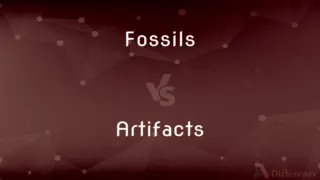Intensive Properties vs. Extensive Properties — What's the Difference?
Edited by Tayyaba Rehman — By Fiza Rafique — Published on November 17, 2023
Intensive properties are independent of mass, like temperature. Extensive properties depend on mass, like volume.

Difference Between Intensive Properties and Extensive Properties
Table of Contents
ADVERTISEMENT
Key Differences
Intensive Properties are properties of a material that don't depend on the amount of substance present. For example, if you have a sample of gold and another sample of twice its size, both will have the same melting point.
Extensive Properties, on the other hand, are properties that do vary with the amount of substance. In the previous example, the larger gold sample would have double the mass of the smaller one.
Intensive Properties are essential in characterizing a substance's inherent qualities. Density and boiling point are examples of such properties. Regardless of how much of the substance you have, these properties remain consistent.
Extensive Properties, in contrast, help in determining the quantity of a substance. Mass and volume are prime examples. More of a substance means greater mass and volume, making these properties dependent on the amount.
Intensive Properties, being independent of quantity, are used as identifiers for substances. They can assist in distinguishing one substance from another.
ADVERTISEMENT
Extensive Properties provide insights into the scale or amount of a system. They change as the system size changes, which is why they're considered "extensive."
Comparison Chart
Dependence on Amount
Independent of amount
Depends on the amount of substance
Examples
Temperature, pressure, density
Mass, volume, total energy
Role
Characterize inherent qualities
Determine the quantity of a substance
Change with System Size
Remain constant
Vary with size of system
Used as
Identifiers for substances
Indicators of system's scale
Compare with Definitions
Intensive Properties
Intensive properties characterize a substance's inherent qualities.
The density of gold is an intensive property that helps identify its purity.
Extensive Properties
Extensive properties are not inherent characteristics of a substance.
The total energy of a system, an extensive property, depends on the system's size and conditions.
Intensive Properties
Intensive properties do not scale with system size.
The color of a liquid, an intensive property, remains the same whether you view a drop or a gallon.
Extensive Properties
Extensive properties help in quantifying a substance.
The amount of heat in a system, an extensive property, can give insights into the energy content.
Intensive Properties
Intensive properties remain constant across varying sample sizes.
Whether you have a teaspoon or a tank of mercury, its temperature remains an intensive property.
Extensive Properties
Extensive properties vary based on the amount of substance present.
The mass of an object is an extensive property; more material means greater mass.
Intensive Properties
Intensive properties are used to distinguish one substance from another.
The specific heat capacity of a metal is an intensive property that can differentiate between metals.
Extensive Properties
Extensive properties change as the system size changes.
If you combine two identical samples of a substance, the total volume, an extensive property, would double.
Intensive Properties
Intensive properties are those which don't change with the amount of substance.
The boiling point of water is an intensive property because it remains constant regardless of the amount.
Extensive Properties
Extensive properties indicate the scale of a system.
The volume of gas in a container is an extensive property that can change with added or removed gas.
Common Curiosities
Can Intensive Properties be used to identify a substance?
Yes, intensive properties like boiling point or density can help identify a substance.
Does the volume of a substance represent an Intensive or Extensive Property?
Volume represents an Extensive Property.
What are Intensive Properties?
Intensive properties are those which don't change with the amount of substance.
Is temperature an Intensive or Extensive Property?
Temperature is an Intensive Property.
Does the color of a substance represent an Intensive or Extensive Property?
Color represents an Intensive Property.
What are Extensive Properties?
Extensive properties vary based on the amount of substance present.
How do Intensive and Extensive Properties differ?
Intensive properties are independent of substance amount, while extensive properties vary with it.
Do Intensive Properties change with system size?
No, they remain constant regardless of system size.
Do Extensive Properties characterize the inherent qualities of a substance?
No, they determine the quantity or scale of a system.
Can Intensive Properties help in quantifying the amount of a substance?
No, intensive properties characterize inherent qualities, not quantity.
Is mass an Intensive or Extensive Property?
Mass is an Extensive Property.
Can Extensive Properties remain constant for varying sample sizes?
No, extensive properties change with varying sample sizes.
Are both Intensive and Extensive Properties important in the study of materials?
Yes, both types of properties offer valuable information about materials.
Can the total energy of a system be considered an Intensive Property?
No, the total energy of a system is an Extensive Property.
Can two samples of the same substance have different Intensive Properties?
No, intensive properties remain constant for a given substance.
Share Your Discovery

Previous Comparison
Fossils vs. Artifacts
Next Comparison
TIF vs. TIFFAuthor Spotlight
Written by
Fiza RafiqueFiza Rafique is a skilled content writer at AskDifference.com, where she meticulously refines and enhances written pieces. Drawing from her vast editorial expertise, Fiza ensures clarity, accuracy, and precision in every article. Passionate about language, she continually seeks to elevate the quality of content for readers worldwide.
Edited by
Tayyaba RehmanTayyaba Rehman is a distinguished writer, currently serving as a primary contributor to askdifference.com. As a researcher in semantics and etymology, Tayyaba's passion for the complexity of languages and their distinctions has found a perfect home on the platform. Tayyaba delves into the intricacies of language, distinguishing between commonly confused words and phrases, thereby providing clarity for readers worldwide.












































